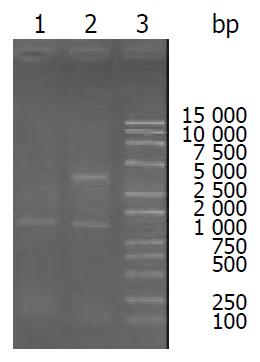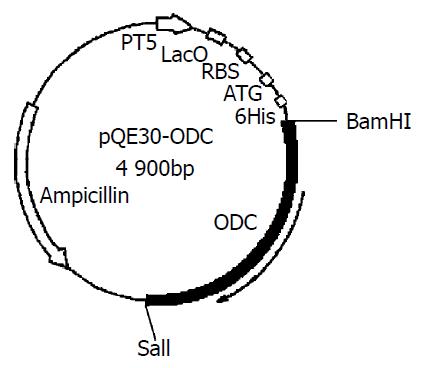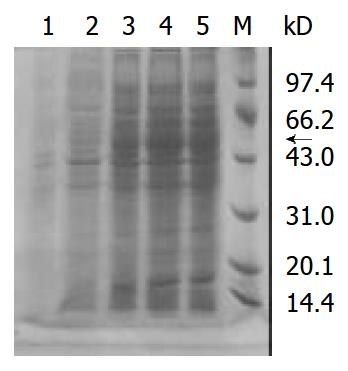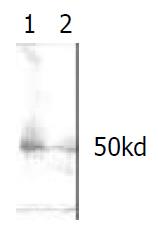Published online Apr 15, 2003. doi: 10.3748/wjg.v9.i4.714
Revised: October 24, 2002
Accepted: October 31, 2002
Published online: April 15, 2003
AIM: To construct and express ODC recombinant gene for further exploring its potential use in early diagnosis of colorectal carcinoma.
METHODS: Total RNA was extracted from colon cancer tissues and amplified by reverse-transcription PCR with two primers, which span the whole coding region of ODC. The synthesized ODC cDNA was cloned into vector pQE-30 at restriction sites BamH I and Sal I which constituted recombinant expression plasmid pQE30-ODC. The sequence of inserted fragment was confirmed by DNA sequencing, the fusion protein including 6His-tag was facilitated for purification by Ni-NTA chromatographic column.
RESULTS: ODC expression vector was constructed and confirmed with restriction enzyme digestion and subsequent DNA sequencing. The DNA sequence matching on NCBI Blast showed 99% affinity. The vector was transformed into E. coli M15 and expressed. The expressed ODC protein was verified with Western blotting.
CONCLUSION: The ODC prokaryote expression vector is constructed and thus greatly facilitates to study the role of ODC in colorectal carcinoma.
- Citation: Hu HY, Liu XX, Jiang CY, Zhang Y, Bian JF, Lu Y, Geng Z, Liu SL, Liu CH, Wang XM, Wang W. Cloning and expression of ornithine decarboxylase gene from human colorectal carcinoma. World J Gastroenterol 2003; 9(4): 714-716
- URL: https://www.wjgnet.com/1007-9327/full/v9/i4/714.htm
- DOI: https://dx.doi.org/10.3748/wjg.v9.i4.714
Ornithine decarboxylase (ODC) is the first key enzyme of the biosynthesis of polyamine which catalyzes the decarboxylation of the amino acid ornithine to the diamine putrescine. Its activation regulates the metabolism of spermidine, spermine and their precursor putrescine. Activity of polyamine biosynthesis is closely associated with the proceeding of physiological cell growth, proliferation and regeneration[1] and pathological proliferation[2]. It is necessary for cell to progress into S phase, or polyamine depletion arrest cells in G1[3]. ODC activity and polyamine concentration in colorectal cancers are significantly elevated compared with that in normal adjacent and healthy control tissues on rodents[4-7] and human beings. ODC repressor (e.g. Difluoromethylornithine) has been considered to be one of the molecular targeted interventions of colon cancer[8]. The changing of ODC activity is an early event during the expression of malignancy. In this study, an ODC expression vector expressing a 6His-tag fusion protein was successfully constructed. The 6His-tag enabled us to purify the fusion protein with high purity.
Trizol, RNA extract reagent, were purchased from Life Technologies Inc. RT-PCR kit, T-A clone kit, DNA marker and all restrictive enzymes were purchased from TaKaRa Shuzo Co.Ltd. Primers were synthesized by Sangon. The QIAquick Gel Extraction Kit, and expression system were got from QIAGEN. Protein marker was purchased from Shanghai Lizhudongfeng biotechnologies Co.Ltd. Standard ODC was purchased from Sigma.
Colorectal carcinoma and respective adjacent normal colorectal mucus were obtained during surgery. Once the specimens were removed during operation, the necrotic and ulcerated tumors were removed and the normal mucosa was dissociated from the muscle and connective tissue. All specimens were then kept in liquid nitrogen until further use.
The total cellular RNA was extracted from normal and cancer tissues, respectively. The method of RNA extraction was similar to the Trizol RNA extraction protocol (Life Technologies Inc.). The concentration of RNA extracted was determined at wavelength of 260 nm using U-2000 spectrophotometer (HITACH Ltd, Tokyo, Japan).
The sequence of ODC primers was as follows, up-stream primer: 5’-gcaggatccaccatgaacaactttggtaa; down-stream primer: 5’-gaagtcgacctacacattaatactagccg. The 5’primer recognized the start codon of ODC in exon 3, and the 3’primer recognized the end-codon in exon 12. Restriction sites were BamH I and Sal I. The first strand of cDNA was synthesized at 55 °C for 30 min in the presence of AMV reverse transcriptase (0.5 unit/µl), RNase inhibitor 1 unit/mL, dNTP 1.0 mM, Mg2+ 2.5 mM. The PCR was processed through 35 cycles of denature (1 min at 95 °C), annealing (1.5 min at 58 °C), and extension (1 min at 72 °C) (Perkin-Elmer2400 PCR apparatus).
The PCR products were separated in 1% agarose gel, and the band containing ODC cDNA was cut off and placed into the QIAquick spin column, the ODC cDNA was purified and linked to plasmid pMD-18 with a polyA linker. The recombinant was transformed into E. coli. DH5α and selected by selective culture medium containing ampicillin.
The pMD-ODC and pQE30 were digested by restrictive enzymes BamH I and Sal I. The inserted fragment of pMD-ODC was collected from electrophoretic gel, then it was ligated with the linearized pQE30 by T4 Ligase at 18 °C overnight. The recombinant was transformed into E. coli DH5α by CaCl2 method and selected by agar plate containing ampicillin and confirmed by restriction enzyme mapping. The positive recombinant was transformed into E. coli. M15.The sequence of inserted fragment was confirmed by DNA sequencing (Shanghai Sangon Bioengineering Co.Ltd.).
The ampicillin-resistant colony of E. coli cells transformed with plasmid were cultured in LB cultural medium containing 100 mg/L ampicillin and 25 mg/L Kanamycin, and induced by 1 mM IPTG. The cultured cells were harvested at 1, 2, 3, 4 hr after culture, respectively. The optimum time of maximum expression of proteins was analyzed through SDS-PAGE. The expressed ODC protein was tested through Western blot with specific antiserum.
RT-PCR was done with total RNA template extracted from human colon cancer. The designed primers include encoding sequence of ODC. Electrophoresis of RT-PCR products confirmed the length of RT-PCR fragment (1480 bp) (Figure 1).
The purified ODC cDNA was ligated to pMD-18 by T-A complimentary pairing. ODC cDNA was inserted into pQE30 at BamH I and Sal I sites (Figure 2).
Sequence of inserted DNA was analyzed with automatic sequence analyzer and found to be about 1500 bp in size and showed 99% affinity in comparison with DNA sequence published on line [gi: 4505488].
Inserted ODC gene was expressed significantly in the prokaryotic expression system, and specific strip at 50 kDa was demonstrated in Western blot. The optimum induction period is 4 hr after administration of IPTG (Figure 3, Figure 4).
The polyamines are naturally occurring aliphatic polycations found in almost all living cells[9]. They are positively charged at neutral pH and the charge is distributed along the length of the molecule. This facilitates their interaction with anionic molecules such as DNA and RNA[9,10]. Polyamines have been shown to be essential for optimal rates of cell growth and differentiation, with high concentrations being found in rapidly growing cells and tissues[11].
Cancer cells always have a higher intracellular polyamine content than the equivalent normal tissue[12-15]. In addition to changes in polyamine content, ODC activity has also been found to be increased significantly in colon adenocarcinoma tissue compared to microscopically normal tissue from the same patients[13,16]. Similar findings were observed in human colonic surgical specimens with both ODC activity and polyamine content of the malignant tissue being increased[16,17]. Intratumour content of spermidine and spermine was increased in line with the increase in ODC activity.
Ornithine decarboxylase (ODC) is a rate-limiting enzyme in the biosynthesis of polyamines, and is induced in response to many growth stimuli such as hormones, growth factors, and tumor promoters, it has a rapid turnover rate with half-life at 15 minutes[18]. Numerous studies have demonstrated that regulation of ODC can occur at multiple levels, including the transcription of protooncogene c-myc[19-22], mRNA translation[10,23,24], protein turnover[10,25,26], and post-transcriptional interactions and modifications[27-30]. Recent studies focus intensely on ODC and polyamine regulation as therapeutic targets. Inhibitors of ODC were found to suppress tunor formation in experimental models of bladder, breast, colon, and skin carcinogenesis[31-35].
Colorectal cancer is a major health problem in the western world and is associated with significant morbidity and mortality. First-line therapy is radical surgery with adjuvant chemotherapy commonly being treatment with antimetabolites such as 5-fluorouracil[30]. Although great clinical efforts have been made for the therapy of colorectal cancer with new technologies, such as CT or MRI colography[4,14], there is still much to be done on the early diagnosis and treatment. It is suggest that ODC activity and polyamine content may have interest in the diagnosis of malignancy and prognosis[15]. As the change of ODC activity is an early event in the development of the disease, it may be helpful for early screening and diagnosis of colon cancer.
We designed two primers from human ODC gene including the start codon (ATG) in exon 3 and the termination codon (TAG) so as to amplify the whole encoding sequence about 1480 bp of ODC. The exons encode a protein is identical to the 461-amino acid sequence derived from human ODC.
The restriction fragment mapping of the recombinant, pQE 30-ODC, indicated that the inserted fragment was about 1.5 kb, which was consistent with the encoding sequence of ODC. ODC activity in the lysate of transformed M15 was demonstrated through Western blot. The expressed fusion protein is about 50 kDa, which is similar to the known ODC protein. The construction and expression of recombinant ODC provide a tool for ODC related further study.
Edited by Ren SY
| 1. | Jeevanandam M, Petersen SR. Clinical role of polyamine analysis: problem and promise. Curr Opin Clin Nutr Metab Care. 2001;4:385-390. [RCA] [PubMed] [DOI] [Full Text] [Cited by in Crossref: 15] [Cited by in RCA: 15] [Article Influence: 0.6] [Reference Citation Analysis (0)] |
| 2. | Auvinen M. Cell transformation, invasion, and angiogenesis: a regulatory role for ornithine decarboxylase and polyamines? J Natl Cancer Inst. 1997;89:533-537. [RCA] [PubMed] [DOI] [Full Text] [Cited by in Crossref: 52] [Cited by in RCA: 58] [Article Influence: 2.1] [Reference Citation Analysis (0)] |
| 3. | Bowlin TL, McKown BJ, Davis GF, Sunkara PS. Effect of polyamine depletion in vivo by DL-alpha-difluoromethylornithine on functionally distinct populations of tumoricidal effector cells in normal and tumor-bearing mice. Cancer Res. 1986;46:5494-5498. [PubMed] |
| 4. | Umar A, Viner JL, Hawk ET. The future of colon cancer prevention. Ann N Y Acad Sci. 2001;952:88-108. [RCA] [PubMed] [DOI] [Full Text] [Cited by in Crossref: 25] [Cited by in RCA: 27] [Article Influence: 1.1] [Reference Citation Analysis (0)] |
| 5. | Rozhin J, Wilson PS, Bull AW, Nigro ND. Ornithine decarboxylase activity in the rat and human colon. Cancer Res. 1984;44:3226-3230. [PubMed] |
| 6. | Hixson LJ, Garewal HS, McGee DL, Sloan D, Fennerty MB, Sampliner RE, Gerner EW. Ornithine decarboxylase and polyamines in colorectal neoplasia and mucosa. Cancer Epidemiol Biomarkers Prev. 1993;2:369-374. [PubMed] |
| 7. | Giardiello FM, Hamilton SR, Hylind LM, Yang VW, Tamez P, Casero RA. Ornithine decarboxylase and polyamines in familial adenomatous polyposis. Cancer Res. 1997;57:199-201. [PubMed] |
| 8. | Pegg AE, Shantz LM, Coleman CS. Ornithine decarboxylase as a target for chemoprevention. J Cell Biochem Suppl. 1995;22:132-138. [PubMed] |
| 9. | Thomas T, Thomas TJ. Polyamines in cell growth and cell death: molecular mechanisms and therapeutic applications. Cell Mol Life Sci. 2001;58:244-258. [RCA] [PubMed] [DOI] [Full Text] [Cited by in Crossref: 673] [Cited by in RCA: 645] [Article Influence: 26.9] [Reference Citation Analysis (0)] |
| 10. | Wallon UM, Persson L, Heby O. Regulation of ornithine decarboxylase during cell growth. Changes in the stability and translatability of the mRNA, and in the turnover of the protein. Mol Cell Biochem. 1995;146:39-44. [RCA] [PubMed] [DOI] [Full Text] [Cited by in Crossref: 16] [Cited by in RCA: 16] [Article Influence: 0.5] [Reference Citation Analysis (0)] |
| 11. | Seiler N, Atanassov CL, Raul F. Polyamine metabolism as target for cancer chemoprevention (review). Int J Oncol. 1998;13:993-1006. [PubMed] |
| 12. | Kingsnorth AN, Wallace HM. Elevation of monoacetylated polyamines in human breast cancers. Eur J Cancer Clin Oncol. 1985;21:1057-1062. [RCA] [PubMed] [DOI] [Full Text] [Cited by in Crossref: 38] [Cited by in RCA: 37] [Article Influence: 0.9] [Reference Citation Analysis (0)] |
| 13. | Wallace HM, Caslake R. Polyamines and colon cancer. Eur J Gastroenterol Hepatol. 2001;13:1033-1039. [RCA] [PubMed] [DOI] [Full Text] [Cited by in Crossref: 68] [Cited by in RCA: 69] [Article Influence: 2.9] [Reference Citation Analysis (0)] |
| 14. | Faaland CA, Thomas TJ, Balabhadrapathruni S, Langer T, Mian S, Shirahata A, Gallo MA, Thomas T. Molecular correlates of the action of bis(ethyl)polyamines in breast cancer cell growth inhibition and apoptosis. Biochem Cell Biol. 2000;78:415-426. [RCA] [PubMed] [DOI] [Full Text] [Cited by in Crossref: 25] [Cited by in RCA: 24] [Article Influence: 1.0] [Reference Citation Analysis (0)] |
| 15. | Cañizares F, Salinas J, de las Heras M, Diaz J, Tovar I, Martinez P, Peñafiel R. Prognostic value of ornithine decarboxylase and polyamines in human breast cancer: correlation with clinicopathologic parameters. Clin Cancer Res. 1999;5:2035-2041. [PubMed] |
| 16. | Linsalata M, Caruso MG, Leo S, Guerra V, D'Attoma B, Di Leo A. Prognostic value of tissue polyamine levels in human colorectal carcinoma. Anticancer Res. 2002;22:2465-2469. [PubMed] |
| 17. | Takami H, Koudaira H, Kodaira S. Relationship of ornithine decarboxylase activity and human colon tumorigenesis. Jpn J Clin Oncol. 1994;24:141-143. [PubMed] |
| 18. | Pegg AE. Recent advances in the biochemistry of polyamines in eukaryotes. Biochem J. 1986;234:249-262. [RCA] [PubMed] [DOI] [Full Text] [Cited by in Crossref: 1170] [Cited by in RCA: 1224] [Article Influence: 31.4] [Reference Citation Analysis (0)] |
| 19. | Evan GI, Wyllie AH, Gilbert CS, Littlewood TD, Land H, Brooks M, Waters CM, Penn LZ, Hancock DC. Induction of apoptosis in fibroblasts by c-myc protein. Cell. 1992;69:119-128. [RCA] [PubMed] [DOI] [Full Text] [Cited by in Crossref: 2151] [Cited by in RCA: 2206] [Article Influence: 66.8] [Reference Citation Analysis (0)] |
| 20. | Bello-Fernandez C, Packham G, Cleveland JL. The ornithine decarboxylase gene is a transcriptional target of c-Myc. Proc Natl Acad Sci USA. 1993;90:7804-7808. [RCA] [PubMed] [DOI] [Full Text] [Cited by in Crossref: 538] [Cited by in RCA: 617] [Article Influence: 19.3] [Reference Citation Analysis (0)] |
| 21. | Packham G, Cleveland JL. Ornithine decarboxylase is a mediator of c-Myc-induced apoptosis. Mol Cell Biol. 1994;14:5741-5747. [RCA] [PubMed] [DOI] [Full Text] [Cited by in Crossref: 157] [Cited by in RCA: 154] [Article Influence: 5.0] [Reference Citation Analysis (0)] |
| 22. | Iyengar RV, Pawlik CA, Krull EJ, Phelps DA, Burger RA, Harris LC, Potter PM, Danks MK. Use of a modified ornithine decarboxylase promoter to achieve efficient c-MYC- or N-MYC-regulated protein expression. Cancer Res. 2001;61:3045-3052. [PubMed] |
| 23. | Kahana C, Nathans D. Translational regulation of mammalian ornithine decarboxylase by polyamines. J Biol Chem. 1985;260:15390-15393. [PubMed] |
| 24. | Shantz LM, Pegg AE. Translational regulation of ornithine decarboxylase and other enzymes of the polyamine pathway. Int J Biochem Cell Biol. 1999;31:107-122. [RCA] [PubMed] [DOI] [Full Text] [Cited by in Crossref: 91] [Cited by in RCA: 92] [Article Influence: 3.5] [Reference Citation Analysis (0)] |
| 25. | Lu L, Stanley BA, Pegg AE. Identification of residues in ornithine decarboxylase essential for enzymic activity and for rapid protein turnover. Biochem J. 1991;277:671-675. [RCA] [PubMed] [DOI] [Full Text] [Cited by in Crossref: 47] [Cited by in RCA: 55] [Article Influence: 1.6] [Reference Citation Analysis (0)] |
| 26. | Dircks L, Grens A, Slezynger TC, Scheffler IE. Posttranscriptional regulation of ornithine decarboxylase activity. J Cell Physiol. 1986;126:371-378. [RCA] [PubMed] [DOI] [Full Text] [Cited by in Crossref: 48] [Cited by in RCA: 53] [Article Influence: 1.4] [Reference Citation Analysis (0)] |
| 27. | Heller JS, Fong WF, Canellakis ES. Induction of a protein inhibitor to ornithine decarboxylase by the end products of its reaction. Proc Natl Acad Sci USA. 1976;73:1858-1862. [RCA] [PubMed] [DOI] [Full Text] [Cited by in Crossref: 211] [Cited by in RCA: 265] [Article Influence: 5.4] [Reference Citation Analysis (0)] |
| 28. | Fogel-Petrovic M, Vujcic S, Miller J, Porter CW. Differential post-transcriptional control of ornithine decarboxylase and spermidine-spermine N1-acetyltransferase by polyamines. FEBS Lett. 1996;391:89-94. [RCA] [PubMed] [DOI] [Full Text] [Cited by in Crossref: 36] [Cited by in RCA: 41] [Article Influence: 1.4] [Reference Citation Analysis (0)] |
| 29. | Ruhl KK, Pomidor MM, Rhim JS, Tuan RS, Hickok NJ. Post-transcriptional suppression of human ornithine decarboxylase gene expression by phorbol esters in human keratinocytes. J Invest Dermatol. 1994;103:687-692. [RCA] [PubMed] [DOI] [Full Text] [Cited by in Crossref: 3] [Cited by in RCA: 4] [Article Influence: 0.1] [Reference Citation Analysis (0)] |
| 30. | Flamigni F, Campana G, Carboni L, Rossoni C, Spampinato S. Post-transcriptional inhibition of ornithine decarboxylase induc-tion by zinc in a difluoromethylornithine resistant cell line. Biochim Biophys Acta. 1994;1201:101-105. [RCA] [DOI] [Full Text] [Cited by in Crossref: 3] [Cited by in RCA: 3] [Article Influence: 0.1] [Reference Citation Analysis (0)] |
| 31. | Thompson HJ, Ronan AM. Effect of D,L-2-difluoromethylornithine and endocrine manipulation on the induction of mammary carcinogenesis by 1-methyl-1-nitrosourea. Carcinogenesis. 1986;7:2003-2006. [RCA] [PubMed] [DOI] [Full Text] [Cited by in Crossref: 21] [Cited by in RCA: 20] [Article Influence: 0.5] [Reference Citation Analysis (0)] |
| 32. | Nigro ND, Bull AW, Boyd ME. Inhibition of intestinal carcinogenesis in rats: effect of difluoromethylornithine with piroxicam or fish oil. J Natl Cancer Inst. 1986;77:1309-1313. [PubMed] |
| 33. | Loprinzi CL, Messing EM, O'Fallon JR, Poon MA, Love RR, Quella SK, Trump DL, Morton RF, Novotny P. Toxicity evaluation of difluoromethylornithine: doses for chemoprevention trials. Cancer Epidemiol Biomarkers Prev. 1996;5:371-374. [PubMed] |
| 34. | Carbone PP, Douglas JA, Larson PO, Verma AK, Blair IA, Pomplun M, Tutsch KD. Phase I chemoprevention study of piroxicam and alpha-difluoromethylornithine. Cancer Epidemiol Biomarkers Prev. 1998;7:907-912. [PubMed] |
| 35. | Love RR, Carbone PP, Verma AK, Gilmore D, Carey P, Tutsch KD, Pomplun M, Wilding G. Randomized phase I chemoprevention dose-seeking study of alpha-difluoromethylornithine. J Natl Cancer Inst. 1993;85:732-737. [RCA] [PubMed] [DOI] [Full Text] [Cited by in Crossref: 58] [Cited by in RCA: 55] [Article Influence: 1.7] [Reference Citation Analysis (0)] |












